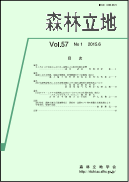Volume 55, Issue 2
Displaying 1-11 of 11 articles from this issue
- |<
- <
- 1
- >
- >|
-
Article type: Preface
2013 Volume 55 Issue 2 Pages 67-68
Published: December 25, 2013
Released on J-STAGE: April 03, 2017
Download PDF (209K) -
Article type: Article
2013 Volume 55 Issue 2 Pages 69-73
Published: December 25, 2013
Released on J-STAGE: April 03, 2017
Download PDF (661K) -
Article type: Article
2013 Volume 55 Issue 2 Pages 75-81
Published: December 25, 2013
Released on J-STAGE: April 03, 2017
Download PDF (2315K) -
Article type: Article
2013 Volume 55 Issue 2 Pages 83-98
Published: December 25, 2013
Released on J-STAGE: April 03, 2017
Download PDF (8564K) -
Article type: Report
2013 Volume 55 Issue 2 Pages 99-104
Published: December 25, 2013
Released on J-STAGE: April 03, 2017
Download PDF (808K) -
Article type: Report
2013 Volume 55 Issue 2 Pages 105-111
Published: December 25, 2013
Released on J-STAGE: April 03, 2017
Download PDF (1794K) -
Article type: Report
2013 Volume 55 Issue 2 Pages 113-118
Published: December 25, 2013
Released on J-STAGE: April 03, 2017
Download PDF (619K) -
Article type: Article
2013 Volume 55 Issue 2 Pages 119-126
Published: December 25, 2013
Released on J-STAGE: April 03, 2017
Download PDF (1307K) -
Article type: Article
2013 Volume 55 Issue 2 Pages 127-132
Published: December 25, 2013
Released on J-STAGE: April 03, 2017
Download PDF (2672K) -
Article type: Report
2013 Volume 55 Issue 2 Pages 133-137
Published: December 25, 2013
Released on J-STAGE: April 03, 2017
Download PDF (774K) -
Article type: Report
2013 Volume 55 Issue 2 Pages 139-143
Published: December 25, 2013
Released on J-STAGE: April 03, 2017
Download PDF (1786K)
- |<
- <
- 1
- >
- >|
